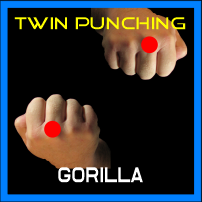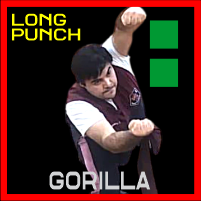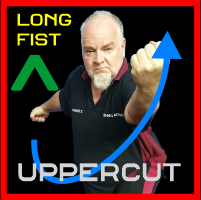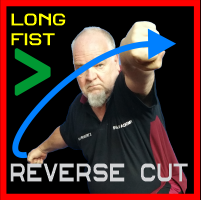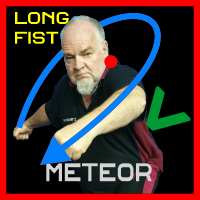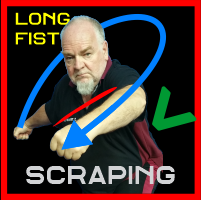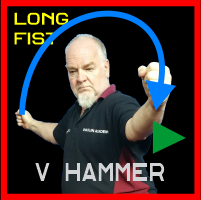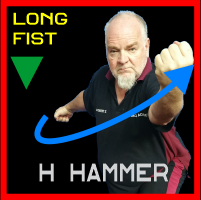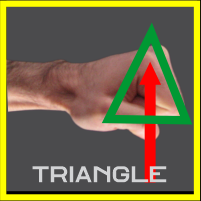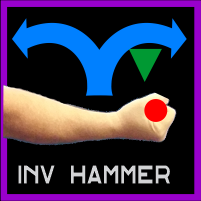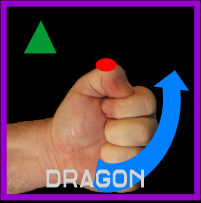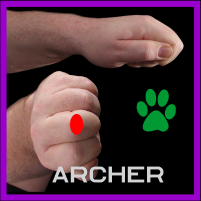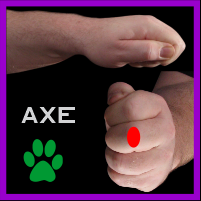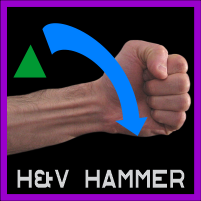
Shaolin Academy speciality Fists.
🢄Main Academy Page 🢀Ret to Kung Fu Page☎Call us 0458 742654 @email us
Links to Available Levels
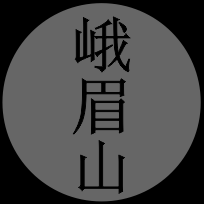
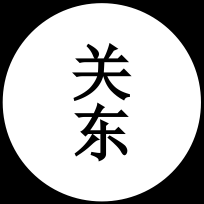
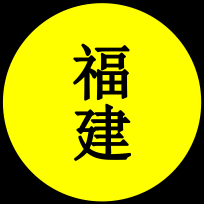
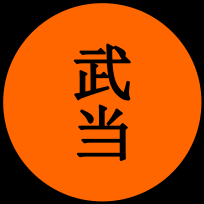
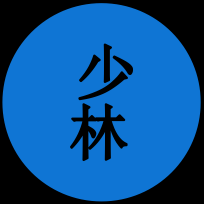


Punching and Fists Menu
Choose the right tool for what you need.
On this page...
On this page we explore the various kung fu clenched fist techniques, how they work. and how to use them. Where available, each "Techniques Tile" is click able and opens a new video window with an explanation. To return back to hear, close the window. If nothing happens when you click on a tile, there may not be a video attached. Usually there will be an explanation below the tiles instead.
Intro
In the first five levels we only use the 'Standard Clenched Fist but in three variations and four ways'. It is a tightly closed first. Initially, we only use the large proximal phalanx, the large middle finger knuckle at the hand, supported by the index finger knuckle and thumb on the one side and the ring and little finger knuckles on the other side. When punching in line with your arm, you align this knuckle with your arm's center through to the elbow but do not lock any of your joints! Always leave a small bend as a suspension and safety system for your future. Yes, in principle, the Square, Sun, Triangle and Knocking fists are identical, except for the angle at the wrist based, and which part is used to impact. The Panther fist is unique in this group. Following we have variations of the foundation five.
The 4/5 Basic Clenched Fists
In many cultures, the fist is a sign of anger, aggression, and violence and many martial arts developed alternate ways of hitting. But there is no denying that the clenched fist is the most used for fighting and defence. It makes sense! You are less likely to get your finger caught by the attacker or in clothing or some such. Five fingers working together are usually better and safer than using open hand, claw or finger techniques.
In the Shaolin Academy, we only use fists for punching, in the first five levels. In self defence and competitions, you are safer keeping your hands closed and avoiding a Chin Na finger technique, or stupidly blocking a kick with an open hand. Later, you will learn open hand techniques, but your default hand shape, when active in self defence or competition, should be the closed fist.
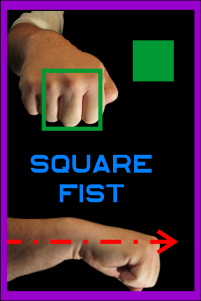
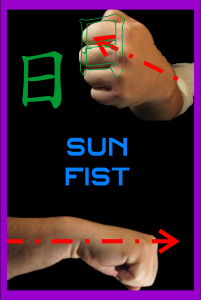
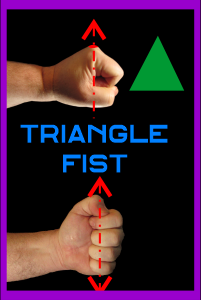
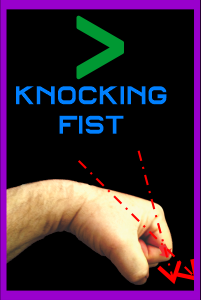
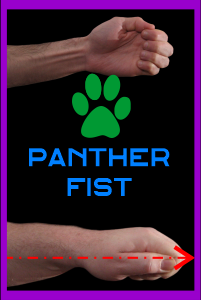
The Square fist is used horizontally, then we call it a Square Fist, or vertically then we call it Sun Fist because of its similarity to the Chinese Sun ideograph. Both these fist punch forward along the arm. When we use the fist vertically as in Back Fist, the shape is the same but the wrist is straightened to allow for some give to protect the wrist. The same fist angled as much as possible is the Knocking or Meteor fist and uses the middle fingers venter knuckle for the impact. The Panther or animal fist also uses the center knuckle for impact. All other fist shapes basically hark back to the clenched and animal fist with some minor variations. In the initial temple levels from Gray to Blue Sash, we use the clenched fist only and explore the:
Basic Strike Deliveries




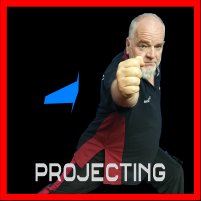

There are five ways you can deliver a basic punch or any striking technique. Direct, round, Whipping, Hammering or Projecting. We devote the 1st, 2nd, 3rd, 4th and 6th level to a delivery principle and introduce you to the concept of double punching in the 1st, 5th then the remaining in the 7
In the initial levels we explore the diverse ways of delivering a punch. We use the close fist to learn how to use and therefore how to defend against the five main punch and hand attacks:
- Straight: and direct punching as in a Straight punch. The shortest distance and all that.
- Round: Cross Cut Punching as in Cross and Upper Cuts. The favored street punch and possibly the most powerful.
- Wiping: When blocks turn into punches and an outside block turns into a hammer fist.
- Whipping: Flick-Whip as in Monkey and Ape. One of the quickest punches and a favorite of Bruce Lee
- Long Punching: as in, well, long punching. The hardest and possibly the most devastating style, Long Punching.
The Wing Chung Chain punching is quite effective and well know so that had to be in the 1st level. To complete the temple levels using the clenched fist, we added the second advanced delivery method, Twin or Two-Punching in the 5the temple level and the remaining all went to the Panther, the 7th technical specialist level. In the same with all the remaining animal fists.
Where available, clicking on a "Tile" will open a video in a new window. Close it to return to where you were. Where not available, the will be a written explanation.
To support us in our task of maintaining this information and updating, we ask for a small yearly contribution through PayPal. It is not much and includes email support from Sijo Robert Z on anything you find on our WEB site.
Temple Levels - Punching
Fist Shapes
Yes, the Square Fist and Sun Fist are the same but angled by 90deg. Still, they are the workhorses and rather than say horizontal or vertical square fist, we simply name them so. The Sun Fist, used for Chain Punching is so named because of the similarity to the simplified Chinese ideogram for Sun. With both these you hit inline with the arm. The Triangle fist is used to hit perpendicular to the arm and thus is angled at the wrist differently to protect the fine bones in the back of your hand.
Initially, all you need to learn is to keep your fist closed and your wrist at the correct angle for the technique so as not to damage your wrist, fingers, or knuckles.
L1 Gray Sash, Emei Shan
The most effective punch (possibly) is the straight punch, a direct line from point 'A' to point 'B'. The Shaolin Academy way is to aim the center knuckle at the intended target. The straight punch for targets below the shoulder line, square and inverted square to around your shoulder line and the inverted straight punch to above you shoulder line. Not that I say your shoulder line. In Shaolin Kung Fu over twenty different stances allow you to very your height significantly and thus we always reference your body and frame unless we state otherwise.
L2 White Sash, Kwantung
The second level focus on round punching, mainly on two of the most common street techniques and the by Bruce Lee popularized Inch Thrust, but a bit different. Round techniques like the Roundhouse Punch, can be some of the most powerful techniques and as mentioned, especially the haymaker roundhouse possibly the one most used in brawls despite being the one most easily countered. The Uppercut Punch is not as easily delivered in normal situations, unless your opponents hands are down and then it can be devastating, even killing if the force culminates in the neck.
The round upper cutting Inch Thrust is for the up-close-and-personal encounters and targets the attackers floating ribs. There is much more to this punch then most people know using a finesse that cannot easily be seen when executed.
L3 Yellow Sash, Fukien
Another punch the Bruce Lee popularized is the super quick whipping Back Fist. In a time when Karate was just a few punches and kicks, Bruce Lee exposed one of the quickest techniques of all although most people still do not comprehend the fullness of the technique. Hardly anyone ever uses the Reverse Fist which usually only target the bridge of the nose. That said, it is great for targeting attacking arms and legs.
The Monkey Fist is unique and a long held secret in some styles. Exactly as the other two, except it comes from below. Its main targets are attacking arms, people bending forward, chin and groin. The Monkey Punch can end a dispute quite quickly, if you know how to use it.
L4 Orange Sash, Wudang
Only one recording currently but the explanation to these punches is fairly straight forward and almost identical to the previous level in the PUNCHING (delivery). The Whipping Punches from the precious level use the triangle fist's center knuckle. This is not good if you wish to kit something hard. For strikes to hard surfaces, like the forehead, the hammer punch is best. It is delivered exactly the same as the Back, Reverse, or Monkey punch, except, just before impact, you "Flick" the wrist into the hammer shape. The third Hammer, the inverted Horizontal Hammer works the same as an Inside or outside Block from Gray Sash, but turned into a strike. For more info, check out. Shaolin Academy Blocks Gray Sash.
The Knocking Fist uses the middle fingers center knuckle, much in the same way as if you were knocking on a front door. Generally you would target the chest but for a better defensive outcome, the part just under the nose is much more effective.
Please train the Hammer Punch the short version, from in front of your body not from beside your ear. The one mostly shown here is the Long Fist Hammer Punch that we cover in Red Sash, Tiger Kung Fu.
L5 Blue Sash, Two Handed Punches
Sometimes people over complicate things. This is just the same as what you learned, just with both hands at the same time: The Twin punches are like a solid push, just with fists. Almost all the Twin Punching techniques can be used for almost any of the previous Fists, except the Gorilla Punch. That is, as it is. All five option are demonstrated by Sifu Martyn in the form of a Twin Punching routine.
Punching with both hands at the same time is rarely taught outside of traditional kung fu styles mainly because it is rarely practical. But for Shaolin Kung Fu, this is body, mind, and skill development and thus very important to Shaolin pracitioners. Usually, most people have a dominant hand which is then better coordinated and stronger. With this exercise we help the other hand to catch up and become just as usable in defence as the dominant hand. So, you may never use a twin punch to defend yourself but practicing the skill will help you in many ways, including control, targeting, timing and judgment. Your 'other' hand will also become more coordinated.
The graphic tiles explain the five methods adequately, so here are some detail notes:
- Punch with both arms equally strong.
- Impact with both arms at the same time.
- Start with gentle, slow punching and gradually increase strength and speed but only as much as your weakest arm.
- Synchronize your breathing to exhale on impact.
- When working on a bag, listen to the impact to know if your achieving your outcomes.
The Gorilla Punch is a proper traditional technique. Its correct usage is shown in the Red Sash, Tiger level. First you need to train to impact with both upper and lower fist at the same time before you learn the traditional technique. The targets for this technique are the opposing pectoral muscles and floating ribs, ie., left chest, right floating ribs or right chest left floating ribs.
Advanced Shaolin Animal Kung Fu Levels
L6 Red Sash, Tiger
The Tiger is a just do type of style. While others are hesitating, the Tiger finishes the job. Building on the tigers ability of a sudden leaping attack, we allocated the Long Style of Kung Fu punches to this level.
L7 Purple Sash, Panther
The Panther is the tactician, technician, and strategist. It knows every technique in detail. The Panther kung fu stylist needs to understand the system of techniques so there is a lot of Punching and Fists to cover: especially the Panther and Animal Fists.
The Panther is always different, unusual, unconventional, even chaotic but, and that is a big but, you first need to learn everything in a structured and understand order before you can also understand chaos. Many believe the absence of order is chaos but in fact the other is more correct. The universe is dark with tiny areas of light and so too, the universe is chaos with tiny areas of order (just go with this analogy). Understand the order that most human beings need to have and then you will understand how chaos works.
From all this, you need to learn the Fists, some of which you already covered. But now you need to know them well including how to use thein Permutations:
Permutations of Punching, again.
To support us in our task of maintaining this information and updating, we ask for a small yearly contribution through PayPal. It is not much and includes email support from Sijo Robert Z on anything you find on our WEB site.
I have a question or I need help- Call us between 11am and 5pm, Tuesday to Friday & Sunday on 0458 742 654 that is 0458 SHAOLIn
- e-mail us at the Shaolin Academy
- Drop into any of our venues at least 30 minutes before class start.
- Or in a special case, you can also arrange a personal meeting with Master Robert Z. You can call him on 0458 742 654 (0458 SHAOLIn).
ⒼIf you like, tell Google! 👂If not, tell us
☎Call us 0458 742654 @email us


























